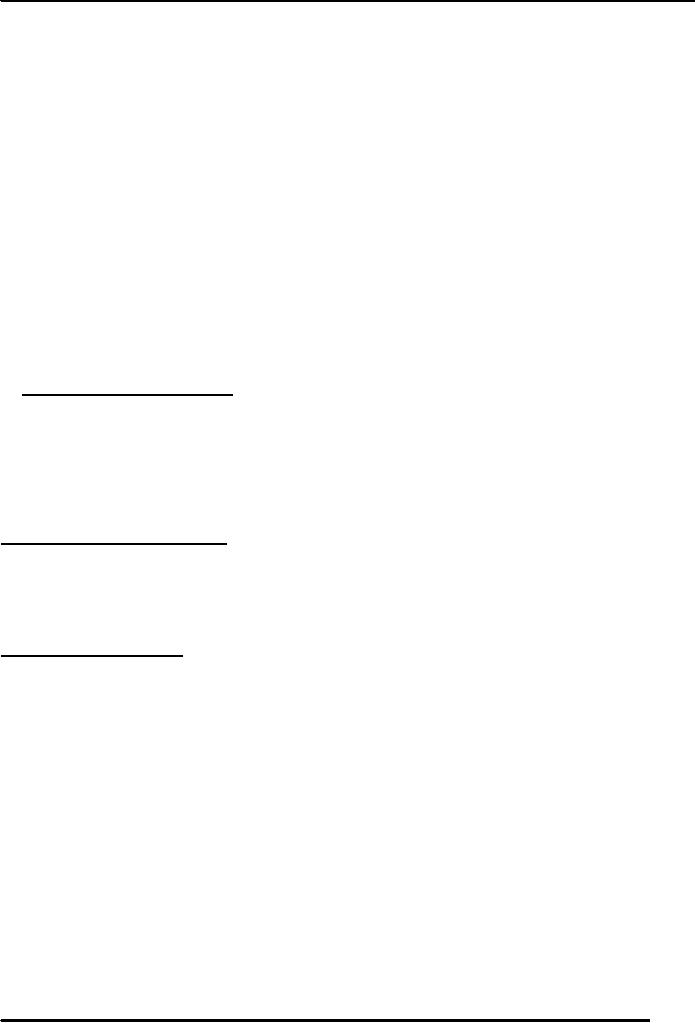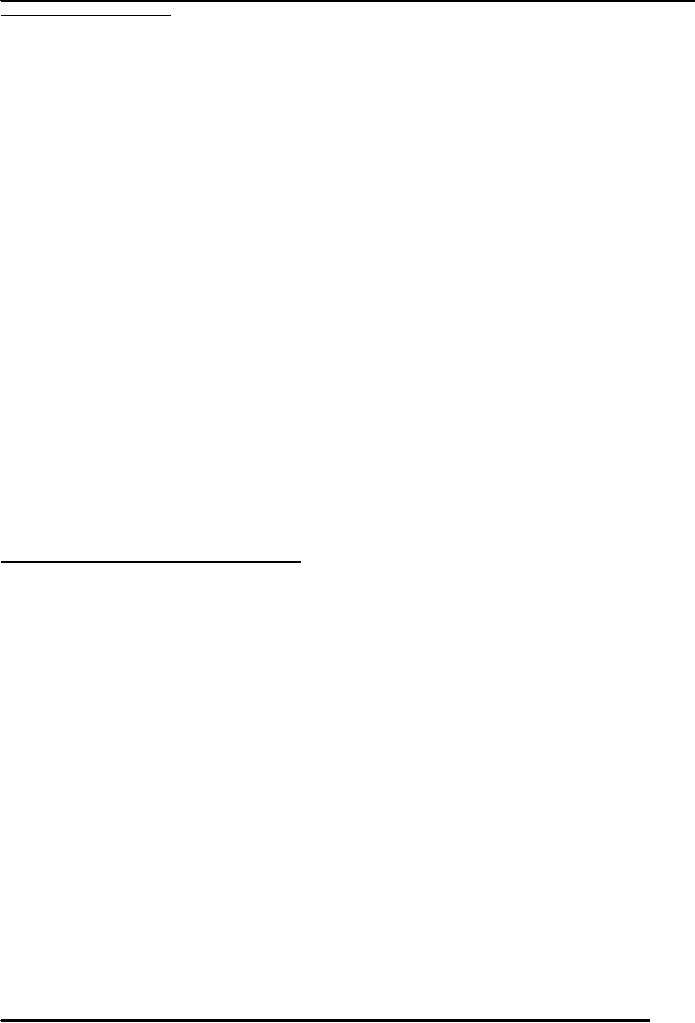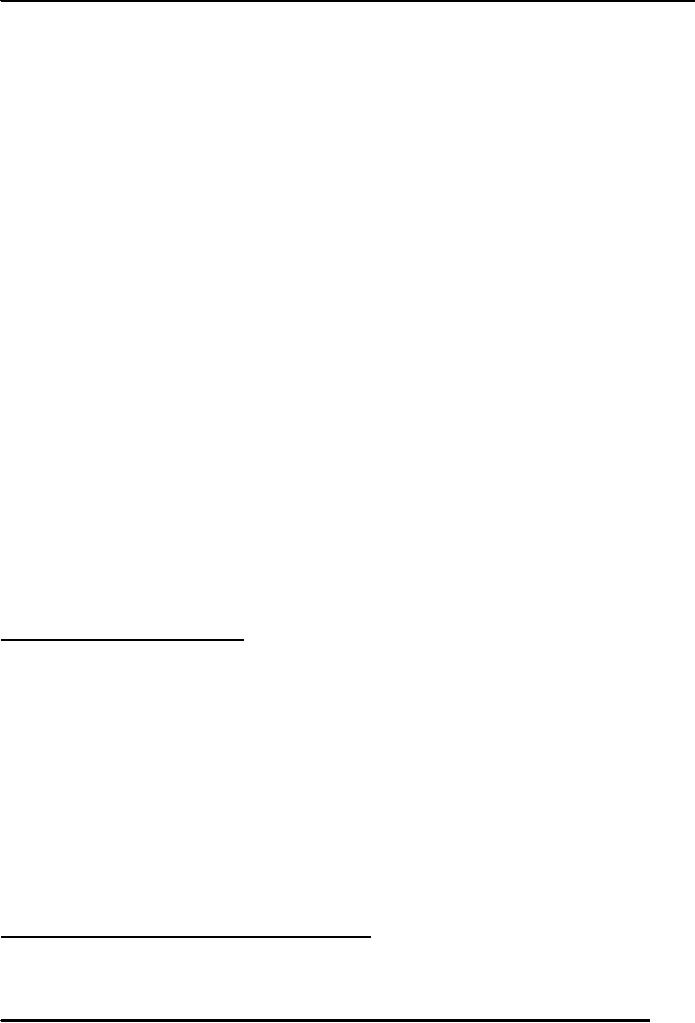 |

Human
Relations MGMT611
VU
Lesson
43
REVIEW-I
What
is a Human Relation?
1.
2.
Meanings
of Communication
3.
Culture
and Personality
4.
Personality
and Stress
5.
Perception
and Individual
behaviour
6.
What
is Group?
7.
Attitude
and Behaviour
8.
Theories
of Motivation
9.
Goal
Setting and
Motivation
10.
Problem
Solving and Cognition
11.
Creativity
and Characteristics of Creative
Workers
12.
Self-Defeating
Behaviour and Self-Defeating
Attitude
13.
Conflict
and Conflict Resolution
14.
Organizational
Communication
15.
Relationship
of Self-Esteem with Childhood,
Media and Public
Image
16.
Mentoring
1.
What is a Human
Relation?
The
term Human Relations in its
broadest sense covers all
types of interactions among people. This
subject
focuses
on the systematic analysis of human
behavior, preventing conflict,
and resolution of behavioral
problems.
In an organization; managers are
concerned with three types
of resources,
Physical
resources;
Financial
resources;
Human
resources;
2.
Meanings of Communication:
Communication
has 3meanings, in any
form
Pure
Meaning: The meaning which I
use through words e.g.
dictionary.
Intended
Meaning: Which I want to convey to another
person in written or spoken
form.
Perceived
Meanings: Those messages
that we convey and how
these are taken by the different
people.
3.
Culture and Personality
Culture:
Culture is
that complex whole which
includes knowledge, beliefs, art,
norms, customs and
any
other
habit acquired by a man as a
member of a society".(Advertiler)
Personality:
Personality
is a sum total of habits,
traits, characteristics of an individual.
It is actually a force
or
power to do things.
Another
important aspect of personality is intelligence
quotient or IQ. In a job
situation employers
are
interested
it see how quickly employees
can pick up instructions, learn
more new skills and
adapt to the
change
in demands such skills are
rewarded and helpful in
developing a successful career
for the individuals
and
increase in organizations
profit.
Types
of Persons: A person is an
entity having a distinct identity
with certain distinguishable
and
persistent
characteristics.
1.
Type A: The
Type A personality is characterized as
fast moving, hardworking, time
conscious,
comparative,
impatient and preoccupied
with work.
2.
Type B: The
Type B personality is the opposite of Type A
which is commonly associated with
stress and
is
usually liked by the organizations
today.
131

Human
Relations MGMT611
VU
4.
Personality and Stress
There
is a deep relationship between "personality
and stress". Stress
plays a very important role in
every
day
life of an individual and is
present in one form or
another. Stress affects the personality
as well as the
performance
of a person. If we understand the
relation between stress and
the personality, how they affect
each
other we will be able to
channalize and manage stress
in a better way.
Two
types of stress
a.
Positive stress-it is
called u-stress; you perform
well due to this stress.e.g.
Stress in exams makes
you
achieve
better marks in the examination.
b.
Negative stress: if
you can't adjust to the
demands of the situation then the stress
is prolonged then this
negative
stress
affects on your performance,
your health and your over
all personality. This aspect
of
personality
is linked with stress.
Stress
is situation
where there are demands on a
person.
·
Social
demands
·
Organizational
demands
·
Situational
demands
Personal
Tools to Control Stress: Tools
of stress and personality enhance the
work performance of a
person.
It is your self confidence to do
things.
Self
perception: Self
perception is the picture you hold
about your self.
Self
awareness:
Knowing your self is self
awareness.
Self
worth: You
should know your own worth
and value of your work.
Basically it is marketing of your
self
as
well as your
capabilities.
Self
love: You
should appreciate your self
and your personality. If you
don't love your self
you have
negative
feelings about yourself which
creates negative
stress.
Self
esteem: Self
esteem is earned through
success and is very important.
Taking responsibility and
accomplishing
the task will help to built
up self esteem.
Self
respect: Your
own feelings about your
self are self respect;
emotion is a respectable energy
and a
powerful
source.
5.
Perception and Individual
Behaviour
"Perception
is a process through which people
select, organize, interpret, retrieve
and respond to
information."
Three
concepts of personality: Communication
has many forms. Everyone who
communicates through a
picture,
verbal design or with a landscape
has its three
meanings.
1.
Intended
meanings, the
meanings which I want to convey to the
audience.
2.
The second meaning is
dictionary
meaning e.g.
communication material, words I have
used.
3.
Most important is "perceived
meanings" the
meanings that you are
getting .your meanings will
b
based
on meanings that you are
getting from the other person's
speech.
Life
World: In
sociology there is a concept
"life
world".
Every person has a different
life world. What are
his
life
experiences? Due to different
experiences a person views
different things in different
way.
Bias
in Perception: Following
are main factors that
influence the process of perception
development.
·
Stereotype
images
·
Expectations
·
Projection
·
Interest
·
Selective
exposure
·
Frame
of reference
132

Human
Relations MGMT611
VU
6.
What is a Group?
The
organizations are using the
word team for the groups
now a day. So a group/team is
"two or more
people
interacting to achieve an objective". This
definition has three major
components: Objective,
Interaction,
and Projective
Why
do People Join Group: People
join groups for a variety of
reasons. Some group members
are
motivated
by task concerns and others
are motivated by interpersonal attraction to
other group members.
1.
Group Synergy: "The
whole is greater than the
sum of its parts, which
also refers to group
synergy.
2.
Support and Commitment: A
group may be more willing to
take on a large project than
would an
individual.
3.
Interpersonal Needs: Individuals
often join a group to meet
their interpersonal needs.
Roles
in Groups
·
Task-Oriented
Roles: These
are several roles which
relate to the completion of the groups
task
·
Social
Roles: Groups
also have members who play
certain social roles:
·
Individualistic
Roles:
These roles place the group
member above the group and
are destructive to
the
group.
7.
Attitude and Behaviour
Attitude:
Attitude
is a usual way of doing things.
Successes and failures in
life depend upon the
attitude of
the
individuals. If attitudes are positive,
then human relations will be positive.
And positive human
relations
are
necessary for a successful
life.
Behaviour:
The
actions or reactions of a person or
animal in response to external or
internal stimuli.
Types
of Attitudes
·
Positive
attitude: The
predisposition that results in desirable
outcomes for individuals
and
organizations
can be described as positive
attitude.
·
Negative
attitude: The
tendency of a person that
results in an undesirable outcome
for individuals
and
organizations can be described as
negative attitude.
How
to change attitude
·
Cognitive
approaches focus
on changing the way people think
about an entity or object.
·
Behavioral
approaches focus
reward and punishments for
certain attitudes and
behaviours.
·
Social
approaches focus
on our tendency to copy the
beliefs and behaviours of
others.
8.
Theories of Motivation
The
Need Theory of Motivation: Personal
needs and wants motivate
people until these are
satisfied. The
need
cycle shows the relationship with
work and achievement:
Need
Drive
Actions
Satisfaction
Maslow's
Hierarchy of Needs: Maslow's
hierarchy of needs show that
people strive to satisfy the
following
needs in a sequential order:
(1)
Physiological
(2)
Safety
(3)
Social
(4)
Esteem
(5)
Self-actualizing
9.
Goal Setting and Motivation
Success
demands identifying goals.
Almost all successful people
set goals and write them
down for personal
reminding.
133

Human
Relations MGMT611
VU
Goal
setting on the Job: Goal
setting is important in both
profit and nonprofit firms,
especially in
technical,
professional and managerial
jobs.
Types
of personal goals: Personal
goals can be divided into
different groups: Social and
family, hobbies
and
interests, physical and
mental health, financial, etc.
Guidelines
for Goal Setting: An action plan is
needed to achieve
goals.
·
Specify
Goals: Vague
goals may delay
action.
·
Concise
Goals: Use a
short, punchy statement.
·
Set
Realistic Goals: A
realistic goal represents the
right amount of challenge for the
person
pursuing
the goal. The higher a person's
self-efficacy, the more likely he or
she may think that
a
goal
is realistic.
·
Set
Goals for Different Time
Periods: Include
daily, short-range, medium-range,
and long-range
goals.
·
Include
Some Fantasy in Personal Goal
Setting: Fantasy
goals reflect a vision of the ideal
type
of
life one would like to
lead. Such goals also
facilitate relaxation.
·
Review
Goals from Time to Time:
Some
goals lose their relevance
and therefore must be
changed.
Techniques
of Self-Motivation
·
Set
goals for yourself: Goal
setting is fundamental to
motivation.
·
Find
intrinsically motivating work:
Intrinsic
motivation refers to the natural tendency
to seek
out
novelty and challenges, to extend
and use one's
capabilities.
·
Get
feedback on your performance: Feedback
acts as a reward.
·
Apply
behavior modification to yourself:
In
using behavior modification,
remember that self-
rewards
may be more effective than
self-punishments in sustaining the right
behavior.
·
Improve
your skills relevant to your goals: According
to the expectancy theory of
motivation,
people
need confidence in their
skills to be motivated.
·
Raise
your level of self-expectation: The
Galatea effect is the technical term for
improving
performance
through raising one's
expectations.
·
Develop
a strong work ethic: If you
are committed to the idea that
most work is valuable
and
that
it is joyful to work hard,
you will automatically become strongly
motivated.
10.
Problem Solving and Cognition
Personality
influences a person's cognitive
style (intuitive skills). It
influences the mental processes
used
to
perceive and make judgments
from available information.
The four dimensions of
psychological
functioning
are: (1)
Introverted
(shy) versus extroverted, (2)
Thinking
versus feeling,(3)
Sensing
versus
intuiting,
and (4)
Judging
versus perceiving.
Ways
to Solve Problems: A
highly recommended way of solving
problems and making decisions is to
use
the
following steps.
1.
Awareness
of the Problem.
2.
Identify
Causes of the Problem.
3.
Find
Creative Alternatives.
4.
Weigh
Alternatives.
5.
Make
the Choice.
6.
Implement
the Choice.
7.
Evaluate the
Choice.
11.
Creativity and Characteristics of Creative
Workers
Creativity:
The
ability to use `imagination' or power of
mind to develop new and
original ideas or things.
Following
are the characteristics of
the creative
workers
1.
Knowledge
134

Human
Relations MGMT611
VU
2.
Intellectual
Abilities
3.
Personality
Improving
creativity: Many
strategies and techniques
can improve creativity, and
all of them help people
move
beyond intellectual constraints. The goal
of these experiences is to think
like a creative
problem
solver.
1.
Concentrate on the problem or task: At
limes, we think we are
thinking intently about
our
problem,
yet in reality we may be thinking
about something that
interferes with creativity.
They
can
hamper the development of new
ideas.
2.
Overcome traditional mindset:
Mental
flexibility helps a person
overcome a traditional
mind
set,
a fixed way of thinking
about objects and
activities. An effective way of
overcoming
a
traditional
mind set into challenge, the
status quo.
3.
Discipline yourself to think laterally:
Vertical
thinking is an analytical, logical
process that results
in
few answers. In contrast, lateral
thinking spreads out to find
many different
alternative
solutions
to a problem. Critical thinking is vertical and
creative thinking is lateral. To
learn to think
laterally,
develop the mental set that
every problem has multiple
solutions.
4.
Conduct brainstorming sessions: The
best-known method of improving creativity
is
brainstorming,
a technique by which group members
think of multiple solutions to a
problem.
5.
Borrow creative
ideas
6.
Negate your own ruts or mental
set
7.
Establish idea quotas for
yourself
8.
Play the roles of explorer,
artist, judge, and lawyer
10.
Forced Associations. A
widely used method of releasing
creativity is the forced-association
technique.
Using this technique, individuals or
groups solve a problem by making
associations
between
the properties of two objects. A link is
found between the properties of the random
object
and
the problem object. The forced
association is supposed to help
solve the problem.
12.
Self-Defeating Behaviour and
Self-Defeating Attitude
·
Self-Defeating
Behaviour: In
today's increasingly complex social
and economic
environment,
most people have to overcome
personal behaviour as they influence
their
personal
and work life.
·
Self-Defeating
Attitude: Self-defeating
attitude is a tendency to act in
such a way that
one's
behaviour works against
his/her own interests, either
intentionally or unintentionally.
·
Positive
attitude
A
positive attitude gives you
the power and confidence to approach
every situation with
the
expectation that you will
ultimately find the right
thing to do -- and then do
it.
Strategies
to overcome Self-Defeating:
1. Examine
Yourself and Make the
Necessary Changes
2.
Stop
Blaming Others for Your
Problems and Cursing
Fate
3.
Solicit
Feedback on Your
Actions
4.
Learn
from Criticism
5.
Stop
Denying the Existence of
Problems
6.
Visualize
Self-Enhancing Behavior
Some
personal problem
·
Drug
Abuse: All
drugs may have serious
side effects (for example,
Relaxants, Heroine).
Getting
Help for Drug Abuse
Problems. Drug abusers, like
alcohol abusers, can also
perceive their
problem
as a disease or maladaptive behavior
thus directing their remedial
strategy.
·
Internet
Dependence: An
Internet dependence (or
addiction) is a condition whereby a
person
spends
so much time on the Internet that
other work suffers and the
person experiences
sleep
deprivation
and neglects human
contact.
·
Coping
with the loss of a relationship:
A major
personal problem many people
encounter is the
loss
of a valued personal relationships,
including separation, divorce, or death.
Loss of intimacy in a
135

Human
Relations MGMT611
VU
relationship
is another significant type of loss. The
person who takes the
initiative in terminating a
relationship
often has to cope with
guilt.
·
Absenteeism
and lateness: Absenteeism
and lateness are the leading
factors of employee
discipline.
They are a form of career
self-sabotage.
·
Depression
and Neurobiological Disorders:
Disturbed emotions and brain
malfunctioning can
interfere
with handling some aspects
of job responsibilities well.
·
Dealing
with anger: Anger
is a feeling of extreme hostility or
displeasure. Anger creates
stress and
results
in physiological changes such as enlarged
pupils, and a flushed face.
13.
Conflict and Conflict Resolution
Conflict
is a
condition that exists when
two sets of demands, goals,
or motives are incompatible or
unmatchable.
Conflict
resolution: Negotiation
is treated as an important way of
resolving conflict.
Why
so Much Conflict Exists?
·
Competition
for Limited Resources
·
The
Generation Gap and
Personality Clashes
·
Aggressive
Personalities
·
Culturally
Diverse Teams
·
Competing
Work and Family
Demands
·
Gender-based
Harassment
The
Good and Bad Side of
Conflict: Conflict
has both positive and
negative consequences, much
like
work
stress. On the positive side, the
right amount of conflict enhances
mental and emotional
functioning
and
may lead to improved
relationships. On the negative side,
intense conflict may lead to
physical and
mental
illness, wasted resources,
sabota9e, excessive fatigue, and
workplace violence including
homicide.
Techniques
for Resolving Conflicts
·
Confrontation
and Problem Solving Leading to
Win-Win
·
Disarm
the opposition
·
Cognitive
Restructuring
·
Appeal
top Third Party
·
The
Grievance Procedure
14.
Organizational Communication
Management
communication is especially important and
most channels of communication with
workers are
based
in the management. The major dimension of
organizational communication is open communication
that
values diversity. In general,
organizational communication is the compounded interpersonal
communication
process across an organization.
Process
of communication: There are
three technical steps for
any communication to occur:
(1)Encoding
(putting ideas into
symbols), (2)
Communication
media,(3)
Decoding
(understanding the
message)
Interpersonal
communication and IT: Advances
in information technology had both
positive and
negative
impacts on interpersonal communicative- E-mail
and tele-comrnunication are two
key domains for
changes
in communication created by information
technology.
Barriers
to Organizational
Communication
·
Perception
·
Emotions
(anger, fear, sadness,
happiness)
136

Human
Relations MGMT611
VU
·
Filtering
(process of altering the message for
more favorable image)
·
Trust
and credibility
·
Information
overload
·
Not
listening (only hearing)
·
Time
and place
·
Media
selection
Improving
communication skills
·
Appeal
to Human Needs and Time
Your Messages
·
Repeat
Your Message, Using More
Than One channel
·
Have
an Empowered Attitude and Be
Persuasive
·
Check
for Comprehension and
Feelings
·
Minimize
Defensive Communication
·
Combat
Info Overload
·
Establishing
Rapport
·
Engage
in Small Talk and constructive
Gossip
·
Improve
Your Telephone and
Voice-Mail and Speakerphone Communication
Skills
·
Use
Presentation Technology to Your
Advantage
Improving
gender barriers to communication: Another
strategy
for overcoming communication
barriers
is to deal effectively with cultural
differences. Two areas of cultural
differences are those
related to
gender
and geography. Gender
differences in communication style have
amused considerable interest,
but
they
must be regarded as cultural stereotypes.
Individual differences in communication
style are usually
more
important than group (men
versus women).
Types
of organizational communication
·
Vertical
Communication
Vertical
communication is the flow of information
both up and down the chain
of command. It is
usually
official information. It is upward and
downward.
·
Horizontal
communication
It
is the flow of information with people on
the same or similar levels in the
organizational
hierarchy.
·
Grapevine
communication (informal)
It
is "the informal transmission of
information, gossip or rumor
from person to person"
The
grapevine
is the informal and unsanctioned
information network within
every organization.
·
Communication
networks
"The
network helps employees make
sense of the world around them and
consequently provides a
release
from emotional stress and
all informal information is
undocumented." (Circle, chain,
all
channel
etc)
Communication
style: The
patterns of behaviors that
others can observe can be
called communication
style.
Basic
communication styles
·
Emotive:
Tends
to express high emotional
opinions. Outspoken, use gestures
and facial
expressions.
·
Directing:
Determined to
come to the top. Tend not to
accept mistakes. Cold and
have no
feelings.
Use always, never,
don't.
·
Reflective:
Tends
to avoid making a decision. Interested in detail.
Formal and avoid displaying
emotions.
137

Human
Relations MGMT611
VU
·
Supportive:
Attempts
to win approval by agreeing with
everyone. Seeks reassurance,
refuses to
take
stand is apologetic.(Situational demands
are important and one could
be flexible to change
style).
·
Versatility
when
we speak of interpersonal relationships (an
interaction involving at least
two
people),
we contend that no one can do
much about what another person
says or does, but each
of
us
can do something about what we
say and do. And
because dealing with others
is such a major
aspect
of our lives, if we can
control what we say and do to
make others more comfortable, we
can
realistically
expect our relationships to be more
positive, or effective.
15.
Relationship of Self-Esteem with
Childhood, Media and Public
Image
Self-esteem:
"Appreciating my own worth
and importance and having the character
to be accountable for
myself
and to act responsibly
towards others." Self-esteem
can be thought of as the sum of
self-confidence
and
self-respect." A child's life is a piece
of paper on which every
passer-by leaves a mark.
Parents do not
teach
their children self-esteem.
But they do shape it with
positive and negative
messages.
Childhood
and self-esteem: Parental
discipline is one way of telling
children that parents care
about them
and
what they do.
Media
and self-esteem: The
media play a strong part in how
adolescents see
themselves.
Self-esteem
and public image:" First-rate people
hire first-rate people. Second- rate
people hire third-rate
people."
Individuals with secure
self-esteem realize that in
helping others succeed, they
benefit themselves
as
well. Acceptance of others is a good
indication that you accept
yourself.
16.
Mentoring
Mentors
are peopling who have
been where you want to go in
your career and who
are willing to act as
your
guide
and friend.
138
Table of Contents:
- HUMAN RELATIONS:Some Guidelines for Effective Human Relations, Communication has 3meanings
- CULTURE AND PERSONALITY:Definition of sub culture, Definition of Personality, Types of Persons
- PERSONALITY AND STRESS:Personality, PERSONAL TOOLS TO CONTROL STRESS
- PERCEPTION AND INDIVIDUAL BEHAVIOUR:Three concepts of personality, Bias in Perception
- PERCEPTION AND GROUP BEHAVIOR:Characteristics of Groups, Individual and Group Behavior
- ATTITUDE AND BEHAVIOUR:Types of Attitudes, Steps to turn attitude into action
- PERSONAL MOTIVATION AND ACHIEVEMENT:Needs and Motivation, Self-discipline and motivation
- SOLVING PROBLEMS SKILLFULLY:Problem solving and cognition, Ways to solve problems
- CREATIVITY IN PROBLEM SOLVING:Barriers to creativity, Tips to solve problems creatively
- HANDLING PERSONAL ISSUES:Self-Defeating Behaviour, Positive attitude to tackle personal problems
- CONFLICT RESOLUTION:WHY SO MUCH CONFLICT EXISTS, TECHNIQUES FOR RESOLVING CONFLICTS
- COMMUNICATION AND HUMAN RELATIONS:Process of communication, Improving gender barriers to communication
- ORGANIZATIONAL COMMUNICATION:To improve listening skills, Types of organizational communication
- UNDERSTANDING COMMUNICATION STYLES:Modeling communication style, Sociability continuum
- SELF-ESTEEM:Building process of self-esteem, Self-esteem and public image
- BUILDING SELF-CONFIDENCE:The importance of self-confidence and self-efficacy, Balanced Self-Confidence:
- BECOMING A LEADER-1:Assessing leadership role, Traits and Characteristics of Effective Leaders
- BECOMING A LEADER-II:Theories of leadership, Developing leadership potential
- GLOBALIZATION AND CROSS-CULTURAL DIFFERENCES:Religious Values and Bicultural Identities
- IMPROVING CROSS-CULTURAL COMPETENCE:Strategies to improve cross-cultural relations, More steps to improve Cultural Relations
- BUILDING GOOD RELATIONS WITH MANAGERS:Impressing your manager, Coping with a problem manager
- BUILDING GOOD RELATIONS WITH CO-WORKERS:Make Co-workers feel important, Maintain Honest and Open Relationships
- BUILDING GOOD RELATIONS WITH CUSTOMERS:Salesperson Represents the Business, Approaching the Customer, Excuses vs. Objections
- CHOOSING A CAREER-1:Ten Myths about Choosing a Career, Attitude toward and Perceptions about Myself
- CHOOSING A CAREER-II:Choosing a career and developing a portfolio Career, Suggestions for career Preparation
- FINDING A JOB:Targeting your job search, The Internet and Résumé Database Services, Extreme Job Hunting
- SIGNIFICANCE OF RESUME:Major types of resumes, Electronic Submission of the Résumé
- IMPROVING INTERVIEW SKILLS:Successful interview, Knowing the employer or Organization
- IMPROVING WORK HABITS-1:Reasons of procrastination, Techniques for Reducing Procrastination
- IMPROVING WORK HABITS-2:Developing the proper attitudes and values, Time-management techniques
- NEW MODEL OF CAREER ADVANCEMENT:Career portability, HUMAN RELATIONS SELF-ASSESSMENT
- TAKING CONTROL OF YOURSELF:Develop Outstanding Interpersonal Skills, Business etiquettes
- EXERTING CONTROL ON OUTSIDE ENVIRONMENT:Important communication tip, Exerting control over the outside world
- MANAGING PERSONAL FINANCES-1:Your personal financial plan, Steps in budget making
- MANAGING PERSONAL FINANCES-2:Basic investment principles, Tolerance for Investment Risks, Types of investments
- ACHIEVING HAPPINESS-1:Finding happiness and enhancing your personal life, The key to happiness
- ACHIEVING HAPPINESS-2:The Five Principles of Psychological Functioning, Your mind and Happiness
- ACHIEVING HAPPINESS-3:Need for intimacy, Working out issues with relationships
- APATHY AND ITS REMEDIES:Let us try to understand the various definitions of apathy, Coping strategies for apathy
- ENHANCING PERSONAL ETHICS-1:Influence of Culture, Common ethical problems
- ENHANCING PERSONAL ETHICS-2:Common ethical problems, Guidelines for Behaving Ethically
- HELPING OTHERS GROW:Being a Nurturing, Positive Person, A list of mentoring behaviour, Coaching skills and techniques
- REVIEW-I:What is a Human Relation?, Meanings of Communication, Two types of stress, Some personal problem, Communication style
- REVIEW-II:Steps to build self-confidence, Globalization, Building Good Relations with Co-workers, Good work habits
- REVIEW-III:New model of career advancement, Choosing your investment, Tactics for Dealing with Difficult People